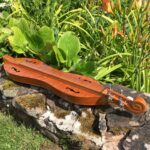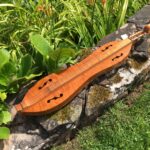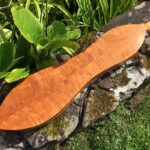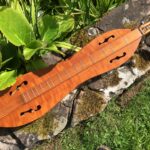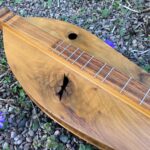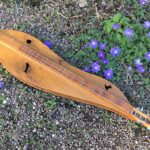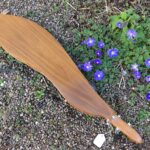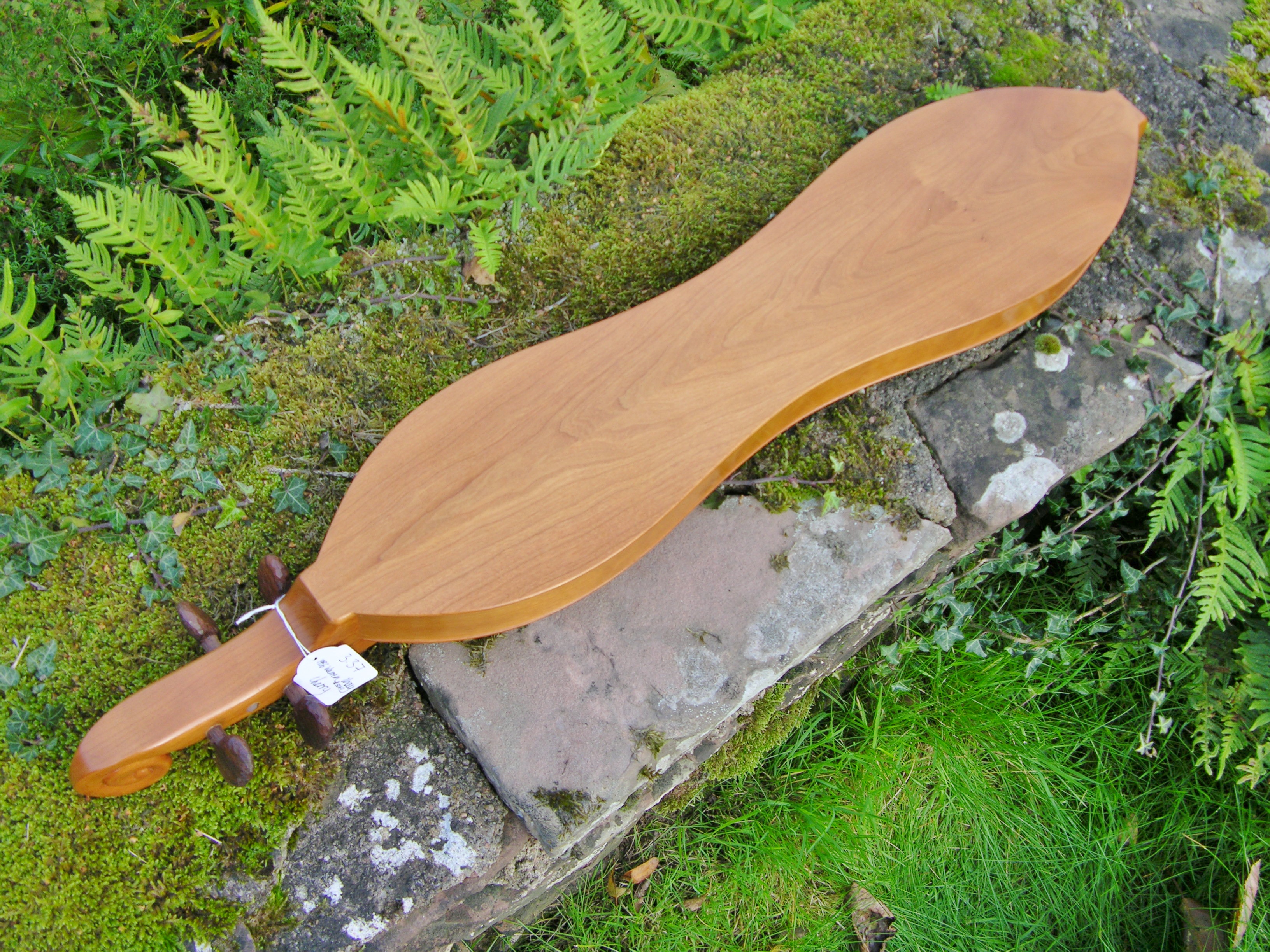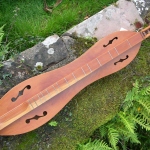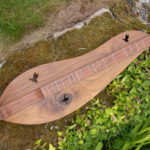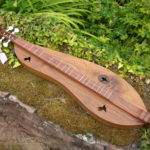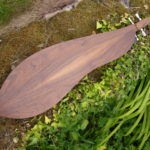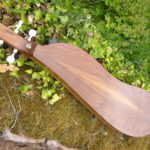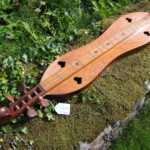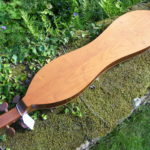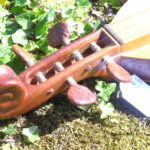Warren May – 4 String Hourglass Dulcimers
Native Kentuckian Warren A. May has spent his lifetime working with wood. Born and raised in a pre-Civil War two-storey log home in Carroll County, Warren was the youngest of ten children. He earned his Bachelor and Masters degrees from Eastern Kentucky University where he was trained in classical woodworking.
Warren has more than forty years of experience in professional furniture and dulcimer making. Both the furniture on display in his shop and the Kentucky mountain dulcimers are made by Warren and his assistants in a workshop located on his farm. Hand work is completed at the Berea, KY shop – including hand carving on furniture, the dovetailing of drawers, cutting of dulcimer soundholes, the installation of frets, and the final “stringing” of the dulcimers.
Native woods from Central Kentucky – walnut, cherry, and tulip poplar – are the most commonly used woods.
3.116 1998 Warren May 4 String 3 Course hourglass #10032 £Sold
Pasted in slip, handwritten, reads “Matt[hew], 6:33 [19]98/ Warren A May/ 110 Center (?)/ Berea Ky/ 40403/ #10,032”.
Very pretty curly cherry body, bookmatched on top, back and sides. Slight fiddle-edging (i.e. top and back overlap sides slightly). The soundholes are in an F-shape. Narrow, closed pegbox and carved scroll in the classic Warren May design, but retro-fitted at some stage with robust, chrome, geared tuners made by Grover, in place of the original wooden friction pegs – but v neatly done. Usual wide, hollow fingerboard – also cherry – with no markings or decorations. No 6+ or 13+ frets. Ebony nut and (?) ditto pyramid-profile floating (i.e. not glued down) bridge. Seems to have the later Warren May scale without the very short first fret, so plays fairly predictably in tune – i.e. the scale is close to, but not exactly, equal temperament. Overall length 34¾”, upper bout 5¾”, lower bout 7⅛”, depth 1¾”, FBW 1⅝”, VSL 26⅜” (medium scale), weight 1lb 11oz (746g). Strings now 12/[12], 16, 26w. No 6+ or 13+ fret.
Works very well in 1:5:5 (DAA or equivalent) tuning and sounds clear and full. The geared tuners are a practical advantage, though presumably not original. The cherry body has real colour and a nice curly figure, and the whole instrument is in remarkable condition for its age. A very practical and melodic investment!
Click on images below to enlarge.
2.237 1987 Warren May 4 string, 3 course hourdrop #4056 £Sold
Handwritten, oblong pasted-in card: “© [?]/ Warren A. May/ 11/87/ Berea Ky/ 40403/ #4056”.
Early, all-solid walnut hourdrop – an asymmetrical half-hourglass, half-teardrop design which Warren might have tried to copyright (hence the symbol?). ‘Natural’ soundholes created from knots in the timber (LB) and carved hummingbird (UB). Otherwise, a traditional, shallow Kentucky-style dulcimer. The original hand-carved wooden pegs have been replaced by decent quality, enclosed chrome guitar tuners. Hollow wooden fingerboard has had the 6+ fret added and guitar strap buttons have been fixed on each end of the body. The original hardwood nut and (floating) bridge have been retained. Overall length 35”, lower bout approx. 7½”, upper bout approx. 4½”, depth 1¾”, FBW 1½”, VSL 26½” (medium scale), weight 2lb 5oz (1048g). Strings now 12/[12], 14, 23w. Updated with 6+ fret (no 13+).
High quality woodworking, as you’d expect from May, but the hard gloss finish shows some cracks around the knot holes where the wood has continued to move. Some light patterning in the finish of the back, where the instrument has been stored on a non-slip mat. Light finger wear on lower fretboard, heavier pick damage to upper fretboard. Plays very easily on its shortish scale, light but clear with some warmth and softness. Ideal for fingerstyle playing or noter-drone work. Intonation best in DAA but works surprisingly well in DAD despite its ‘Kentucky’ scale.
Click on images below to enlarge.
3.88 1986 Warren May #3240 4 string, 3 course cherry hourglass £Sold
Pasted in card, reads “7/86/ Warren May/ Berea Ky/ 40403 3240”. Light dulcimer made entirely from cherry, apart from walnut (?) rustic hand cut pegs. 15 diatonic frets. Bookmatched, figured cherry both on top and back. F-shaped soundholes in UB and LB. Attractive hand-carved scroll and pegbox. Wooden nut and bridge (rosewood?). Older Kentucky-style scale, NOT equal temperament, and thus clearly intended for playing with a noter. So, the distance to the 1st fret is noticeably short, similarly the 4th and 5th – all designed to soften the chords when you play these notes against the open middle and bass strings. IN short, it’s very musical when played against drone strings with a noter, but doesn’t sound right if you try to hold down chords across all strings.
Overall length 35”, lower bout 7½”, upper bout 6”, VSL 26½” (medium scale), weight 1lb 11oz (770g). Hand carved wooden friction tuners. No 6½ fret.
In great condition with scarcely a mark on it after 30+ years. A lovely shimmering cherry body with some attractive grain features and variations of red/orange/yellow colouring. Lightness makes it responsive and it has good sustain.
Click on images below to enlarge.
2.164 #9223 (1996): 4 string, 3 course hourdrop £Sold
Lacquered-in square slip, hand-written: “Warren A May/ 110 Center/ Berea, Ky./ [#] 9223 40403 [zip code]/ [19]96.”
Very pretty, shallow asymmetrical body – May calls it his “hourdrop” shape (i.e. half hourglass, half teardrop). All solid, highly figured walnut with bookmatched back and sides and fiddle edges. The near side teardrop profile has two carved hummingbird soundholes: the far, hourglass side, a spectacular, quilted walnut grain “eye” – basically a knot-hole carved in the shape of another hummingbird. Conventional Warren May hollow fingerboard with branded flower markers at frets 3, 5, 7, and 10. Standard elegant, shallow peghead with carved scroll. High tail with through-holes for ball end strings. Shallow rosewood nut and pyramid-profile floating (i.e. movable) bridge. Heavily updated, probably within the last five years to add the 1+, 6+ and 8+ frets (no 13+ surprisingly) and not particularly carefully. Also the original wooden friction pegs have been replaced with (decent quality) banjo geared tuners. The wooden spacing washers have however been placed on the inside rather than the outside of the pegbox, making some of the string runs a little more awkward than necessary. Overall length 34½”, lower bout approx. 7¾”, upper bout approx. 4⅞”, depth 1¾”, FBW 1½”, VSL 26½” (medium scale), weight 1lb 15oz (893g). Strings now 12, 14, 24w. Updated with 1+, 6+ and 8+ frets (no 13+).
So this is a beautiful and well-constructed dulcimer, created with Warren May’s usual skill. It has a soft sound but a little more volume and better balance with this hourdrop shape. However, the updating has rather compromised its original simplicity and not quite resulted in the intended instrument for modern dulcimer play. The instrument has a fretting pattern which May has called his “Kentucky Scale” and is deliberately not modern equal temperament. The 1st, 5th and 8th frets of this old time scale are typically set a little flat. Played predominantly on the melody string and in 1:5:5 tuning (e.g. DAA), it will sound soft and sweet. But it works less well with 1:5:8 tuning (e.g. DAD) and chord-melody playing – which is what the updating set out to achieve. I have set it to the best compromise available and for most purposes it works well – nice tone, low action, reasonable intonation. This would be suitable for finger-style and noter players in DAA, or general players in DAD who lead predominantly with the melody string. It works less well for complex chord-melody playing in DAD. Has a pick-holder attached to the near-side upper bout.
3.69 #10791 (1999) £Sold
4 string, 3 course hourglass. Pasted in slip, handwritten, reads “Matt[hew], 6:33 [19]99/ Warren A May/ 110 Center (?)/ Berea Ky/ 40403/ #10791”.
Largely cherry dulcimer (top, back and fingerboard) with heart soundholes, the LB ones slanted inwards at the tail. Usual fiddle edges protruding over the sides, which are made from a different and much darker wood – a deep rosewood glow, but possibly a native American tree species. The beautifully carved pegbox and scroll are mahogany, as are possibly the rustic carved pegs. The cherry fingerboard is hollow (?) with brush- or footprint-shaped markers at frets 3, 5, 7 and 10. Wooden nut and floating wooden bridge. Fret spacing is designed to give a scale near to, but not exactly equal temperament. No 6+ fret.
Overall length 34¾”, upper bout 5⅞”, lower bout 7⅛”, depth 1⅝”, FBW 1½”, VSL 26½” (medium scale), weight 1lb 11oz (746g). Hand carved rosewood (?) wooden friction tuners. No 6½ fret. Possible original strings 12/12, 12, 23w.
A clear but warm sound from this light instrument. Rich orangey coloured cherry and darker ?mahogany sides blend well. Scale is Warren May’s later version which has good intonation and works well with noter playing in 1:5:5 tunings, but is not equal temperament.
3.53 #1635 (1982) £Sold
4 string, 3 course hourglass. Pasted-in card, handwritten: “Warren A May [sgnd]/ 11/82/ BEREA, KY/ 40403 #1635”. Traditional all walnut, with bookmatched top and back, fiddle-edged sides, tailpiece and single piece fingerboard. Top has attractive butterfly soundholes in the UB and cleverly uses small natural knotholes in the LB. Headstock and carved scroll are slightly lighter wood and differently figured, but probably still walnut. It has four traditional hand-cut rosewood pegs, deliberately retaining the carving marks, hardwood nut and bridge. Overall length 35”, upper bout 5¾”, lower bout 6⅜”, depth 1⅝”, FBW 1½”, VSL 26⅝” (medium scale), weight 1lb 12oz (788g). Traditional fully diatonic fretboard, i.e. with no 6½ fret . Also has Warren’s early “Kentucky Scale” – a fret placement suited to traditional noter-style playing and 1:5:5 tuning (e.g. DAA or CGG). Original (?) strings 0.012/0/012, 0.012, 0.22w – now 0.012, 0.014, 0.024w.
Plays sweetly and quite loudly, especially with a noter. The scale works less well for finger-style playing or for more modern tunings. See pictures 13 – 15 below.
3.40 #5614 (1990) £Sold
4 string, 3 course hourglass. Pasted in card, reads “8/90 / Warren A May/ Berea Ky 40403/ #5614”.
Beautifully luminous mahogany dulcimer with bookmatched top and back, together with the standard rustic wooden pegs – probably walnut rather than rosewood as later. Hollow single piece fingerboard with 15 frets in total – no zero or 6+ fret – just over 2 octaves. As with #5667 below, has heart soundholes (facing to tail) with LB pair set obliquely towards fingerboard. Usual hand-carved scroll head and carved-out pegbox. Wooden nut and bridge.
Overall length 34½”, upper bout 6”, lower bout 7″, depth 1⅝”, FBW 1½”, VSL 26½” (medium scale), weight 1lb 13oz (821g). No 6½ fret. Strings currently 12/12, 14, 24w.
Looks like a piece of high quality furniture with its unmarked shimmering warm brown mahogany – and that is, after all, Warren’s other trade. BUT, it plays really well, with good sustain, brightness and depth of tone. 1990 must have been a vintage year (see #5667 below). Excellent instrument for diatonic DAA play. See pictures 7 – 9 below.
3.43 #9866 (1997) £Sold
4 string, 3 course hourglass. Pasted in card, handwritten, reads “Matt, 6:33/ [19?]97/ Warren A May/ 110 Centre (?)/ Berea Ky/ 40403/ #9866”.
Overall length 34½”, upper bout 5⅞”, lower bout 7⅛”, depth 1⅝”, FBW 1½”, VSL 26⅝” (medium scale), weight 1lb 12oz (796g). Hand carved rosewood (?) wooden friction tuners. No 6½ fret. Possible original strings 12/12, 12, 22w.
Standard cherry dulcimer with f-holes, but a stunning flecked top, light against a dark background – also cherry or possibly lacewood? Hollow cherry fingerboard with branded markers at frets 3,5,7 and 10. Wooden nut and movable bridge. Space from nut to first fret seems normal, though no 6+ fret. Strap buttons fitted.
Light body gives good volume and tone as always. Very attractive looking dulcimer, particularly with feature wood top which is slightly faceted and very much in keeping with the rustic hand-cut pegs. See pictures 10 – 12 below.
3.37 #3240 (1986): £Sold
4 string, 3 course hourglass. Pasted in card, reads “7/86/ Warren May/ Berea Ky/ 40403 3240”.
Light dulcimer made entirely from cherry, apart from walnut rustic hand cut pegs. 15 diatonic frets. Bookmatched, beautifully figured cherry both on top and back. Different size f-holes in UB and LB. Handsome hand-carved scroll and pegbox. Rosewood (?) wooden nut and bridge.
Overall length 35”, lower bout 7½”, upper bout 6”, VSL 26½” (medium scale), weight 1lb 11oz (770g). Hand carved wooden friction tuners. No 6½ fret.
Fine finish and great workmanship, but this is also a very musical instrument. Has a resonant “Kentucky scale” – a scale which is not perfect according to a digital tuner, but which achieves a rich and attractive blend of sounds when played in DAA or similar – and especially in noter style. See pictures 1 – 3 below.
3.38 #5667 (1990): £Sold
4 string, 3 course hourglass. Pasted in card, reads “9/90 [0r 95]/ Warren May/ Berea Ky/ 5667 40403”.
VERY light dulcimer made entirely from butternut or possibly white oak, with usual walnut rustic carved pegs. Hollow single piece fingerboard with 15 frets in total – no zero or 6+ fret – just over 2 octaves. Looks very similar to Homer Ledford with heart soundholes (facing to tail) and combined tailpiece/string anchor (ball end strings only). But unusually, LB hearts are set obliquely towards fingerboard. Usual hand-carved scroll head and carved-out pegbox. Wooden nut and bridge.
Overall length 34¾”, lower bout 7″, upper bout 5¾”, depth 1¾”, FBW 1½”, VSL 26⅜” (medium scale), weight 1lb 2oz (504g). Hand carved wooden friction tuners. No 6½ fret. Possible original strings 12/12, 12, 22w.
High quality workmanship as usual, with gloss finish. Very sweet, responsive and tuneful, not least because so light. Good intonation and easy action make this a very attractive instrument for diatonic DAA play (see above). See pictures 4 – 6 below.
Click on the thumbnails below to enlarge each photo:

